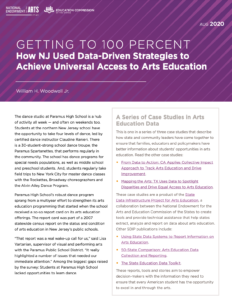THE CASE STUDIES SHARE COMMON LESSONS:
- States collect useful data on arts education, even if they don’t report on it. (To review what data your state collects, see SDIP’s 50-State Comparison: Arts Education Data and Reporting.)
- Partnerships advance the work of arts education data. State government, nonprofits, arts organizations, educators, parent groups and local organizations can all have a role to play.
- Arts organizations often need research partners that can do the work of data analysis.
- Setting benchmarks for success — like universal access to arts education — can help arts education data initiatives focus on the data they need.
- Communities need data at the district and school levels to identify and address local gaps in access and participation.
These case studies are products of the State Data Infrastructure Project for Arts Education , a partnership between the National Endowment for the Arts and Education Commission of the States to create tools and technical assistance that help states extract, analyze and report on data about education in the arts. The other case studies focus on California and Texas:
- From Data to Action: CA Applies Collective Impact Approach to Track Arts Education and Drive Improvement
- Mapping the Arts: TX Uses Data to Spotlight Disparities and Drive Equal Access to Arts Education



